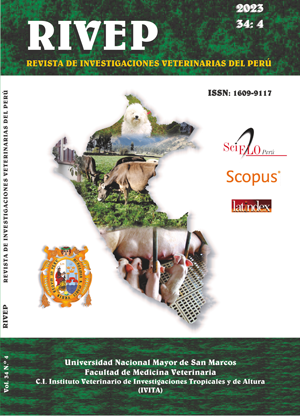Brucellosis in stray dogs from a sector of the city of Talca, Chile
DOI:
https://doi.org/10.15381/rivep.v34i4.25951Keywords:
brucellosis, Brucella canis,, canine, zoonosis, ChileAbstract
The aim of this study was to determine the prevalence of Brucella canis in a population of stray canines using different diagnostic techniques available in Chile and to evaluate their level of concordance. Blood samples were taken and the testicles of 30 stray canines from a sector of the eastern zone of the city of Talca were collected, which were part of a sterilization campaign by the Chilean government. To consider an individual positive for B. canis, at least two positive serological techniques were considered. Clinical examination was performed, and blood samples were analyzed by commercial ELISA, immunochromatography (ICT), counterimmunoelectrophoresis (CIEF), indirect ELISA (ELISA-I) with rough lipopolysaccharide (LPS-R), as well as testicular histopathology. The results showed that 6.6% (2/30) of positive individuals, while the concordance, according to the Kappa analysis was without agreement or poor (-0.136 to -0.023), slight (0.023 to 0.132), fair (0.071-0.380) and moderate (0.464) among the techniques used. It is concluded that there are canines that roam freely around the city with or without clinical signs and with seropositivity or histopathology compatible with brucellosis, which could be a public health problem. The concordance between serological and histopathological techniques indicated that more than one diagnostic technique should be performed, recommending the use of confirmatory techniques (CIEF and ELISA-I B. canis with LPS-R) or the combined use of ICT with commercial ELISA. Histopathology is not recommended as a diagnostic or sole test.
Downloads
Downloads
Published
Issue
Section
License
Copyright (c) 2023 Romy Weinborn A., Macarena Zanelli, Carolina Liendo, Francisco Celis, Sara Olmedo, Francisco Sánchez, Pedro Ábalos, Ignasio Troncoso

This work is licensed under a Creative Commons Attribution 4.0 International License.
AUTHORS RETAIN THEIR RIGHTS:
a. Authors retain their trade mark rights and patent, and also on any process or procedure described in the article.
b. Authors retain their right to share, copy, distribute, perform and publicly communicate their article (eg, to place their article in an institutional repository or publish it in a book), with an acknowledgment of its initial publication in the Revista de Investigaciones Veterinarias del Perú (RIVEP).
c. Authors retain theirs right to make a subsequent publication of their work, to use the article or any part thereof (eg a compilation of his papers, lecture notes, thesis, or a book), always indicating the source of publication (the originator of the work, journal, volume, number and date).










